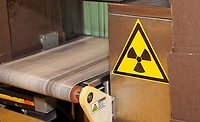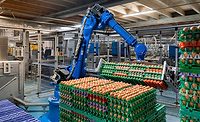Transforming Food Safety: How Autonomous Mobile Robots are Changing the Inspection Game

Credit: Piranka/E+ via Getty Images
Food safety managers today face increasingly complex challenges as they navigate heightened regulatory requirements1,2 and vulnerabilities while managing the high expectations of consumers, all while dealing with a shortage of qualified professionals in the workforce.3 Despite their best efforts, food facilities still struggle with foundational food safety challenges.4 The latest data from FDA5 indicate that about 50 percent of the inspection citations between 2009 and 2023 are related to fundamental issues such as failure to maintain building and physical assets, improper facility layout, lack of sanitation monitoring, failure to provide adequate screening against pests, or lack of implementation of HACCP plans.
Whether a small business or a large corporation, proper maintenance and routine inspections are crucial for ensuring smooth operations. These inspections not only help with regulatory compliance but also early-stage detection of process and product failures.6 However, these routine inspections demand a high level of precision, uniformity, and dependability to meet safety, environmental, and operational benchmarks. They are often time-consuming, resulting in a significant commitment of staff resources. Moreover, for most manual and visual inspection tasks, missed defects typically range from 20 to 30 percent.7 Can the deployment of autonomous mobile robots (AMRs) augment the efforts of food safety professionals by helping them perform inspections?
Unlike traditional robots, AMRs can understand and navigate complicated physical spaces, like production lines, warehouses, shipping docks, and temperature-controlled rooms, without needing help from humans or predefined markers.8 They use wireless communication to connect all the different components of the system, including people, processes, goods, other AMRs, and facilities. This allows them to perform real-time inspections, Cloud-based recordkeeping, generate AI-driven prescriptions for safety managers, and even take corrective actions, if required, all while complying with regulations. AMRs come in different shapes and sizes. They typically have advanced sensors like laser scanners, 3D vision systems, and proximity sensors, as well as AI-enabled processors to help them move around.
Typically, depending on the make or brand, AMRs are trained manually by guiding them to all relevant inspection points along the inspection round.9 These points are identified and saved in the user interface. Using the digital twin or 3D map of the site, the operator can choose which inspection points to monitor by clicking on them on the site-centric user interface. Once selected, the robot will move independently throughout the site, collecting information from the chosen inspection points. Several add-ons can be used with AMRs such as infrared cameras, night vision systems, wheels, tracks, etc.
Considering the fundamental challenges in ensuring food safety, AMRs provide several benefits for overseeing and regulating processes in food facilities, as detailed below.
Inspections in Hazardous Locations
Hazardous locations, which are often enclosed and unsafe for human workers, can now be inspected by AMRs that can enter hard-to-reach spaces. With the ability to see around corners remotely, these robots have become the preferred choice for inspecting hazardous chemical-prone areas and high-pressure, high-temperature, and steam environments.9 Furthermore, these AMRs can reduce audit errors and improve the accuracy and precision of inspection outcomes due to inspector fatigue or poor environmental conditions. With the robots doing the job, food safety professionals can focus on value-added tasks that require human intervention.
Robots as Sanitizers
AMRs equipped with UV-C lights can navigate around a given area to disinfect it.10 This allows the light source to be brought into proximity with every surface, enabling a significantly faster killing dose. The use of autonomous navigation means that the UV-C light source can be moved significantly closer to the target, thereby exponentially increasing the power directed toward each surface. This is particularly useful in food facilities that handle high-risk food items, where rapid and thorough disinfection is crucial. By eliminating pathogens, bacteria, and fungi, these robots can contribute to the creation of safer and healthier environments.
Thermal, Visual, and Acoustic Inspection
AMRs can be employed for carrying out inspections using various sensing technologies such as thermal, visual, and acoustic sensors. The robot uses optical cameras to interpret and capture data from displays and measuring instruments. By utilizing thermal imaging cameras, it can identify flaws in pipelines and detect temperature levels. Furthermore, it can analyze ultrasound and thermal signals to identify patterns and irregularities in electric motors, pumps, and compressors. Additionally, the robot can perform visual inspections to supervise equipment and measure water levels.
Facility Patrolling and Security
Food defense is the protection of food facilities from deliberate contamination or tampering with the intent of causing harm. It involves measures to prevent intentional acts of food contamination or adulteration, such as bioterrorism, sabotage, or economically motivated adulteration. AMRs can autonomously navigate foot patrol routes.11 These robotic patrols are particularly beneficial in extensive locations where the premises can be separated into several protected areas. By conducting video surveillance while patrolling, the robots can provide thorough monitoring and surveillance of each local area, including the remote regions of the site.
Robots for Pest Control
AMRs can detect areas that are affected by pests and determine if the infestation is severe enough to warrant mitigation. They can accurately apply precise amounts of inoculants during spraying, which reduces the amount of chemicals used and lowers costs. Additionally, this method minimizes the possibility of contaminating food with chemicals, and recordkeeping is automated. The autonomous robots can detect infestations in a timely manner and treat them before they cause significant damage. Furthermore, these robots can also perform autonomous floor cleaning, floor scrubbing, and disinfection.
Considerations and Future
AMRs face numerous challenges when employed in the food industry. One of the primary considerations is that the robots must be rated to ensure they can operate among the chemicals, high pressures, and high temperature required in washdown conditions. Moreover, the rugged terrain and obstacles in food processing facilities, such as flights of stairs, inclinations, and water puddles, pose a challenge to the robots' mobility. Additionally, charging the robots' batteries can be constraint for facilities operating around the clock, and the range of the robot is limited by the need to stay within network connectivity. This limits the robots to operating indoors, making them unsuitable for outdoor applications. Also, given the high upfront costs and steep learning curves, the financial viability of using robots for inspections is yet to be determined. However, the future seems promising.
In nutshell, there are several compelling reasons for the use of AMRs as inspection partners, including increased process efficiency, reduced downtime, improved occupational safety, and intelligent data analysis. The future is leaning toward autonomous inspections, and the question is not if but rather when.
References
- Lorenz, A. "2022 Food Safety Report—It don't come easy…" The National Provisioner. February 21, 2022. https://www.provisioneronline.com/articles/112155-2022-food-safety-report-it-dont-come-easy.
- Grover, A. K. "Out of the frying pan and into the fire? Uncovering the impact of FSMA's sanitary food transportation rule on the food logistics industry." Business Horizons 66, no. 2 (2023): 203–214.
- 3 Malone, T. and A. Staples. "Regulatory restrictions are making food supply chain disruptions worse." The Hill. November 30, 2021. https://thehill.com/opinion/energy-environment/583454-regulatory-restrictions-are-making-food-supply-chain-disruptions/.
- Grover, A. K., S. Chopra, and G. A. Mosher. "Food safety modernization act: A quality management approach to identify and prioritize factors affecting adoption of preventive controls among small food facilities." Food Control 66 (2016): 241–249.
- 5 FDA. "Inspections." 2023. https://datadashboard.fda.gov/ora/cd/inspections.htm.
- Ibanez, M. R. and M. W. Toffel. "How scheduling can bias quality assessment: Evidence from food-safety inspections." Management Science 66, no. 6 (2020): 2396–2416.
- See, J. E. "Visual inspection reliability for precision manufactured parts." Human Factors 57, no. 8 (2015): 1427–1442.
- Fragapane, G., R. De Koster, F. Sgarbossa, and J. O. Strandhagen. "Planning and control of autonomous mobile robots for intralogistics: Literature review and research agenda." European Journal of Operational Research 294, no. 2 (2021): 405–426.
- Energy Robotics. "Automating industrial inspection with autonomous mobile robots." 2022. https://www.energy-robotics.com/.
- Ohmnilabs. "OhmniClean Robot." 2023. https://ohmnilabs.com/.
- SMP robotics. "Security patrol robot with PTZ camera." 2023. https://smprobotics.com/products_autonomous_ugv/security-patrol-robot/.
Looking for a reprint of this article?
From high-res PDFs to custom plaques, order your copy today!





